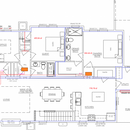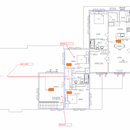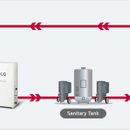Whole home VRF radiant + minisplit?
Hey GBA community!
We’re building a 4b/3ba 2400ft + 800ft ADU in Bend, OR (see attached) this year and I’ve been scouring the internet to find a good VRF solution to run the following off one condenser/heat pump.
I’d like to run radiant floor heating on the first floor and a combination of ceiling cassettes and concealed ducts for heating/cooling the 1st and 2nd floor.
The best I could find so far was a 5 ton LG Multi Vs and even connected with a local rep who seems optimistic it will do the trick.
We plan to build a very air tight structure and pair the system with an HRV.
The ADU will have a separate condenser for heat/cool.
Anyone been down this road already and have some insights to help me make the right choice?
Currently I’m liking the idea of a full LG setup because it’s one manufacturer with one warranty, but I’d love to get some feedback from the professionals on here. 🙂
GBA Detail Library
A collection of one thousand construction details organized by climate and house part












Replies
The house you describe is probably 2 tons total heating load or less at Bend, OR at 20f design temp. I think any full on VRF system that I am aware of is going to be dramatically oversized. This is just a guess, but the heat recovery for water heating in summer won't make up for the sub optimal efficiency in the winter. My understanding is that these are very expensive systems as well.
Something like a pair of ducted Fujitsu 12RLFCD (may even 9RLFCD depending on the insulation levels) for heating and cooling should work. Set up 1:1 they will be fully modulating down to 3000btu/h each. A standard heat pump water heater with possibly drain water heat recovery could take care of hot water. Radiant heat is easy to skip in a tight house unless you are willing to go the cost no object route for minor comfort improvements.
Deleted
I'm with Matt on this.
You have to figure out what problem you are tyring to solve by throwing the VRF at it. The VRF makes sense if you have a large structure (these units were designed for commercial, so BIG house) or you need to heat a pool both summer and winter.
If you are looking for a bit of warm toes feel, electric resistance mat is way cheaper to install and not that much more to operate. They also tend to be more comfortable as you can run them all the time whereas you only notice hydronic floor heat on the coldest of winter days.
If you MUST have a bit of hydronic floor heat, go with a Senden CO2 water heater which can supply around 8kBTU. You can do a fair bit of spot hydronic heat off that.
For overall heating and cooling you can't beat a standard cold temperature mini split.
I should probably add -- we will be installing a grid tied 10kwh+- PV array on the roof with the goal of completely offsetting power consumption (I'll likely put a tesla cybertruck in the garage eventually)
The ADU will be rented so I'm open to running a large enough VRF to run both units and just offsetting the savings with better rent cashflow...what would you estimate the total tonnage or BTU requirement would be for both units?
I have the budget to make the hydronic upgrades and our market shows these items are reflected in the resale price. (I own a local real estate brokerage)
Is there anyone reading this that has gone down this route and can speak from experience?
“The ADU will be rented so I'm open to running a large enough VRF to run both units and just offsetting the savings with better rent cashflow...what would you estimate the total tonnage or BTU requirement would be for both units?”
I’m not sure what savings you are referring to. The VRF will likely have a higher initial instal cost and higher operating cost due to oversizing that the available options.
The ADU could easily be designed to run on 3/4ton and the main house 2x 3/4 ton for heating/cooling plus a pair of heat pump water heaters. Drain water heat recovery would be easy in the main house as well.
Hire a pro like Energy Vanguard to design the system for you. They will guide you to the correct equipment, which probably won’t be Daikin VRF under modern construction until you hit well north of 6000SF.
As for the hydronic system, the need for it decreases dramatically as the heating loads decrease. There are no longer big temperature gradients. I can’t imagine it having a positive ROI on resale vs the options like improving finishes. I would love to see any data you have. Hydronic floors I have seen all run $10-20/sf unless DIY’d.
By savings I meant the utility cost savings for the tenant...
I appreciate what you're saying and the referral...I've reached out to Energy Vanguard will keep you posted.
Best!
https://www.thisoldhouse.com/jamestown-net-zero-house/21053838/net-zero-comes-together-the-jamestown-net-zero-house
They show the setup about 1/2 way through the show.
I'm not disagreeing that people will pay more for floor heat, I just don't think people care how that floor heat is generated. Hydronic heat by itself is expensive. Air source hydro heat is even more costly. Much cheaper ways of getting floor heat.
Unless you have a pool you need to heat, the VRF + Hydro Kit setup just doesn't make sense both in terms of performance (unit is WAY oversized for a house that big including ADU) and cost.
Thanks Akos - that episode is actually what gave me the idea for this system.
I got a quote from Warmboard and their nat gas boiler system is turnkey with 4 zones for about $17,000 not including the floor panels (which I'll probably use the Ecowarm instead due to price and ease of building)
However my thought was using a VRF for both infloor and the splits would be even better.
I might scrap the radiant floor heat altogether once I see the total cost and potential repair/maintenance.
It just sounds soooo nice and if it garners $10-20/ft I'll definitely come out ahead.
Sounds about right. Usually for new build some type of staple up is usually much cheaper than floor panels, I like the ultra fin stuff as it need much less piping and quicker to install.
If you want floor heat, I would go for electric mats in high traffic areas. As long as the mini split is doing bulk of the heat, the energy cost for this is not that much. If you want more efficient put in the Senden and tap some BTU off it (lot more $ for the heater and $$ for hydronic plumbing/install).
I would be curious what the part cost of the VRF setup is, I have a feeling just the part cost will be more than the $10-20/ft extra you are hoping. It would be nice if there was a reasonably priced air source heat pump+water heat setup out there.
You won't find many supporters of radiant floor heat on GBA unfortunately. We are working on a Zone 4 (Brooklyn, NY) remodel project 3 floors with Warmboard specced as the heat emitters and we are in discussions to use that LG VRF multi VS system with Hydrokit for hydronic heating, ducted minisplits and DHW preheat. We have a small 5kw PV array on net metering to work with and our stance is more about comfort and not burning fossil fuels than anything else. I'll subscribe to this thread and let you know how it all goes but we're excited to go all electric.
People are not unsupportive or radiant heat. You have to be realistic about comfort expectations and costs.
In my own home I have radiant floors. The house already had rads and a boiler and since I was doing the work myself, the part cost of radiant floors is less than almost any other heat source so it made a lot of sense.
In some areas it definitely improved comfort. My bedroom is in an overhang, without the radiant heat, even with 16" of insulation, the floors feels cold. The rest of the house you NEVER notice the floor heat. In the dead of winter, you can just feel the floor slightly warmer under some large windows where there is extra piping.
The only way I got the warm toes feel in the bathroom is to run the floor heat there off the hot water recirc line, this way it is independent from the house heat and can run all the time.
As long as you realistic expectations, there is nothing wrong with hydronic floor heat. If you are paying for the system+install, I would think twice about the setup and what you really hope to get for your dollars.
Yes I think that the most important part of the whole radiant floor design is that we just don't want to notice the heat at all, for warm toes feeling we are actually specifying electric radiant in the master bathroom run on a timer as we are pretty scheduled. The boss of the project (read: wife) hates forced air heating which is another driver. This is a gut renovation and I designed the setup with some great input and help from Warmboard and LG engineers after a Manual J ( which cut out some MEP costs) but ultimately we know this is a luxury addition. Luckily the house is located in a very expensive and mostly recession proof part of the country and so the ROI is pretty much guaranteed. The contractor has recently done some Warmboard-S installations and was very happy with the quality of the subfloor and said that even though we were adding about 30% to the cost of the HVAC system we would be very pleased with the result.
The VRF system is the wildcard in the whole project. If it works as calculated both cooling and heating the whole house at a reasonable price as well as doing a decent job at DHW heating then I will consider the project a success, if not we are not going to cap the gas line for a season or two until we have full data and can therefore switch to a more standard fossil fuel solution.
" important part of the whole radiant floor design is that we just don't want to notice the heat at all"
Not quite. What you want to do is size the heated area to supply the heat load for the room without overheating the flooring. You want to put heating only in areas of high traffic. Generally there is no point for floor heat under cabinets, beside interior walls or under any furniture. You want the floor heat only in areas where you'll be walking, around exterior walls and under windows.
Most well insulated places need between 1/3 to 1/2 the floor area heated, when it comes to a hydronic install with something like Warmboard, that is a big cost save. Saves money on parts and labour plus you end up with more enjoyable heat as the floor will feel warmer.
Not sure how if DHW heat is worth it off the VRF. Unless you have huge water supply needs the smallest high temp hydro kit can heat enough water for a couple of houses. You'll need the hydro kit + indirect tank, not cheap.
You are much better off to pre-heat the incoming water off the floor heat buffer tank and use a regular heat pump water heater to bring it up to full temperature. This would be about the same efficiency and much simpler.
Also I think if you only need low temperature hydro kit (which will be more than enough for the floor heat), you can go with smaller Multi VS compressor. This would get the system size closer to your load instead of trying to figure out how to make the 5 Ton unit work.
That was the idea, run both the house + ADU off the Multi Vs
However, I like the pre-heat and finish with heat pump water heater because I think you're right even the Multi Vs will probably be overkill.
What would you recommend for the pre-heat and water pump to loop it?
Would you recommend getting a design done by someone like Energy Vanguard and have the local plumber build it out?
With a complicated setup like this, you need a qualified engineer to design the system. There is no way an hvac contractor can figure this out and have it work properly.
I'm also far from an expert when it comes to these, these are just my thoughts on how I would approach the design.
The simplest would be to go with a small reverse indirect water heater. In these the domestic hot water flows through the internal coil, the tank is connected to your space heat. The incoming water would be automatically heated by the tank in the winter time without any controls or pumps.
Because the domestic hot water is only running through the coil, there isn't a large volume of luke warm water sitting around. None the less, I would plumb the hotwater recirc to return before the buffer tank and program it to run at least 15 min a day to keep the water there from stagnating.
In the summer time, I would just have the HPWH do all the heating, there is no efficiency gained by pre-heating the water with the hydro kit.
The low temp hydro kit can be run with outdoor reset with a max temperature range between 100F to 120F. Make sure you size your emitters accordingly.
I would also talk with someone who does a lot of ducted minisplit work and see if you can visit any past projects. My understanding is that it pretty easy to get these to run in a way where you can not even tell they are on unless you hold a piece of paper up to the register. The cfm are 1/2-1/3 a traditional forced hot air system. When sized right they modulate and run continuously. With properly sized and positioned ceiling registers you don’t feel any airflow.